Creamy Cajun Shrimp Pasta (One Pot!)
~ This ultra easy Cajun Shrimp Pasta recipe features tender, succulent shrimp in a flavorful cream sauce. But unlike many other recipes, this version leverages the one-pot method and some clever ingredients to create all those popular, restaurant-quality Cajun flavors quickly … easily … and MUCH more nutritiously, too! Bonus: It rewarms nicely, for those days when you need to prep dinner ahead of time (or wanna have leftovers for lunch)! ~
This Recipe Is: • Ready in About 30 Minutes • Make Ahead •
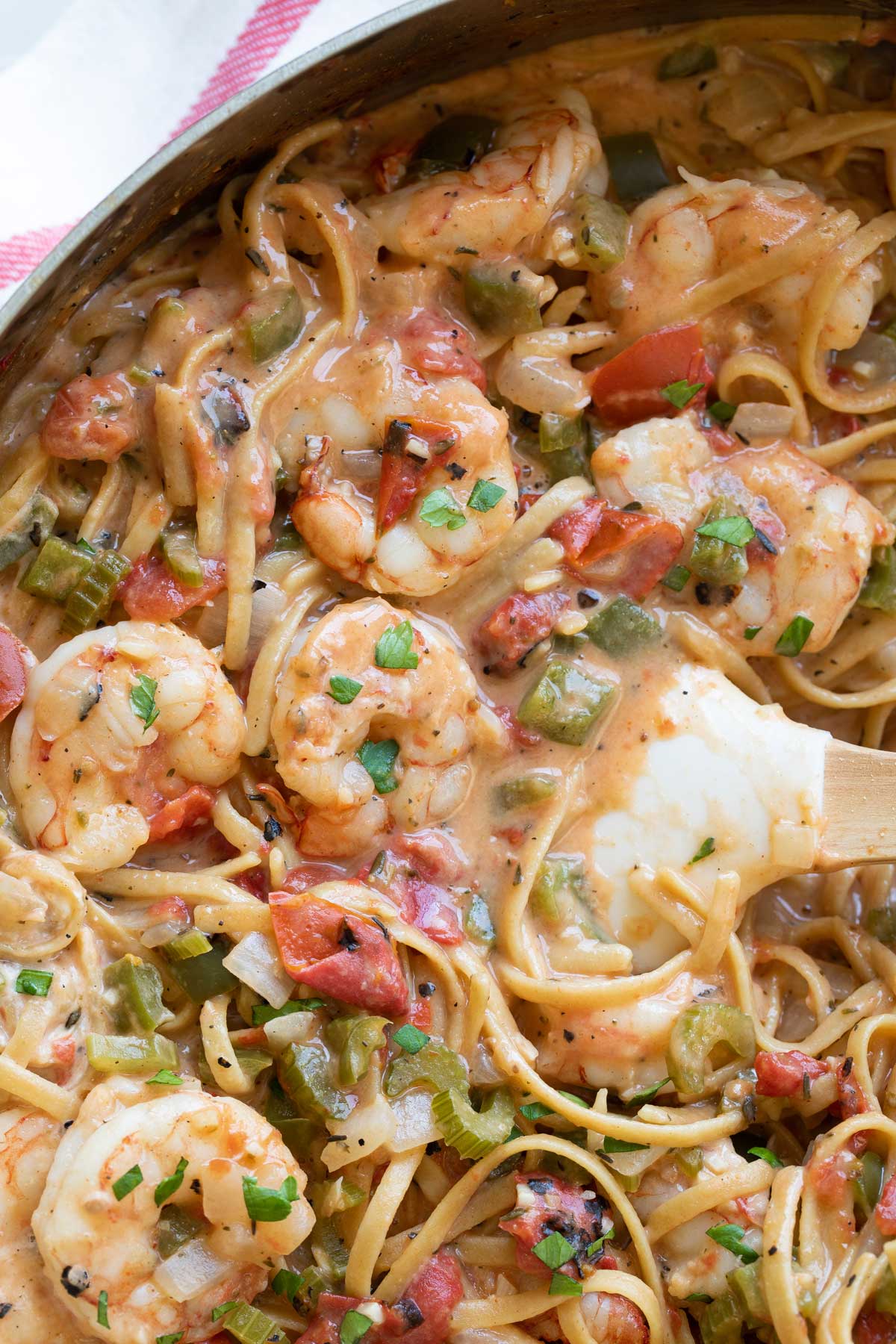
Seems like everywhere you look these days, restaurants have some type of Cajun pasta on the menu. From humble mom-and-pop joints to highbrow, chef-driven dining experiences … they know Cajun cream sauce will sell.
Whether it’s a Cajun shrimp pasta (like this one) or Cajun Alfredo dripping over chicken and veggies, people love it.
Wanna capture all those headliner restaurant vibes at home? Heck yeah, you do (sign me up, too)!
Why Cajun Shrimp Pasta Is So Popular
- It’s full of perfectly cooked, tender, juicy shrimp,
- Draped in a rich, creamy, Alfredo-y sauce,
- Studded with texture and background flavors from the classic “Cajun Trinity” of green pepper, onion and celery,
- Amped up with Cajun spices (kicky but not too, over-the-top hot), and some parmesan cheese for an extra layer of savory-salty-cheesy joy …
- All nestled into twirly strands of al dente pasta.
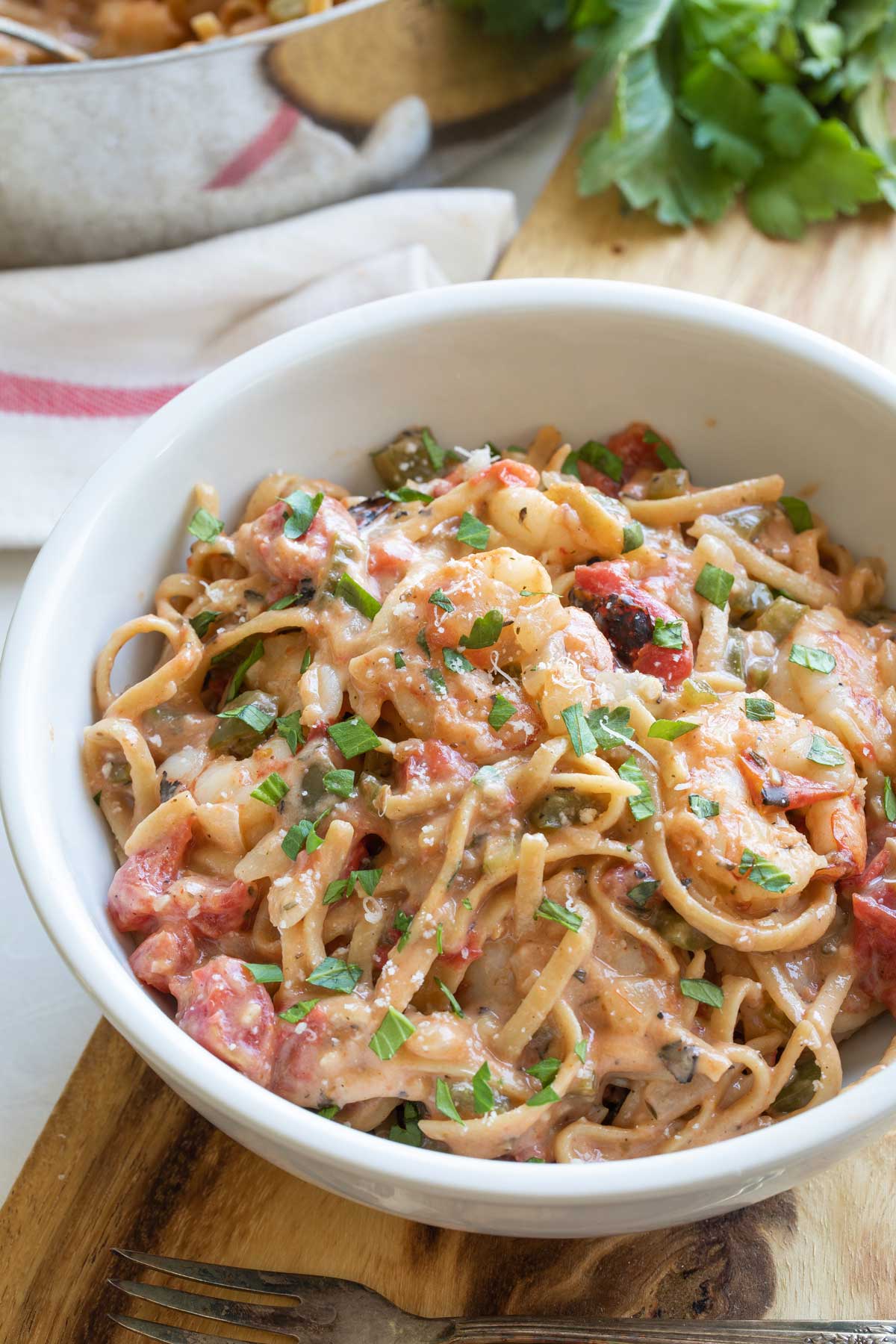
YES! That is a recipe for rampant fan appeal and undying foodie love.
That is why restaurants so often feature some version of Cajun pasta on their menus. Because it’s just so darn good and people can’t get enough.
It’s deeply flavorful, rich and creamy, and oh-so-satisfying.
But There’s a Problem (Two, Actually)
So yes … we all agree that Cajun pasta is delicious. And yes, we wish we could re-create it at home.
But …..
This super-easy “one-pot” version cleverly solves both those problems at once!
One-pot pasta to the rescue!
Why the One-Pot Method Is So Wonderful
I absolutely adore the concept of one-pot pasta recipes.
Ever since our One-Pot Whole-Wheat Pasta with Asparagus, Peas and Parmesan … I’ve been irreversibly addicted to this idea.
It’s pure genius, for a couple reasons.
First, of course, it streamlines both cooking and cleanup, since all the action happens in just one pan. There’s no straining the pasta, either. And, you can serve dinner straight outta the pan you cooked it in.
Easy, easy.
Perfect for the busy home cook (which is me … and you)!
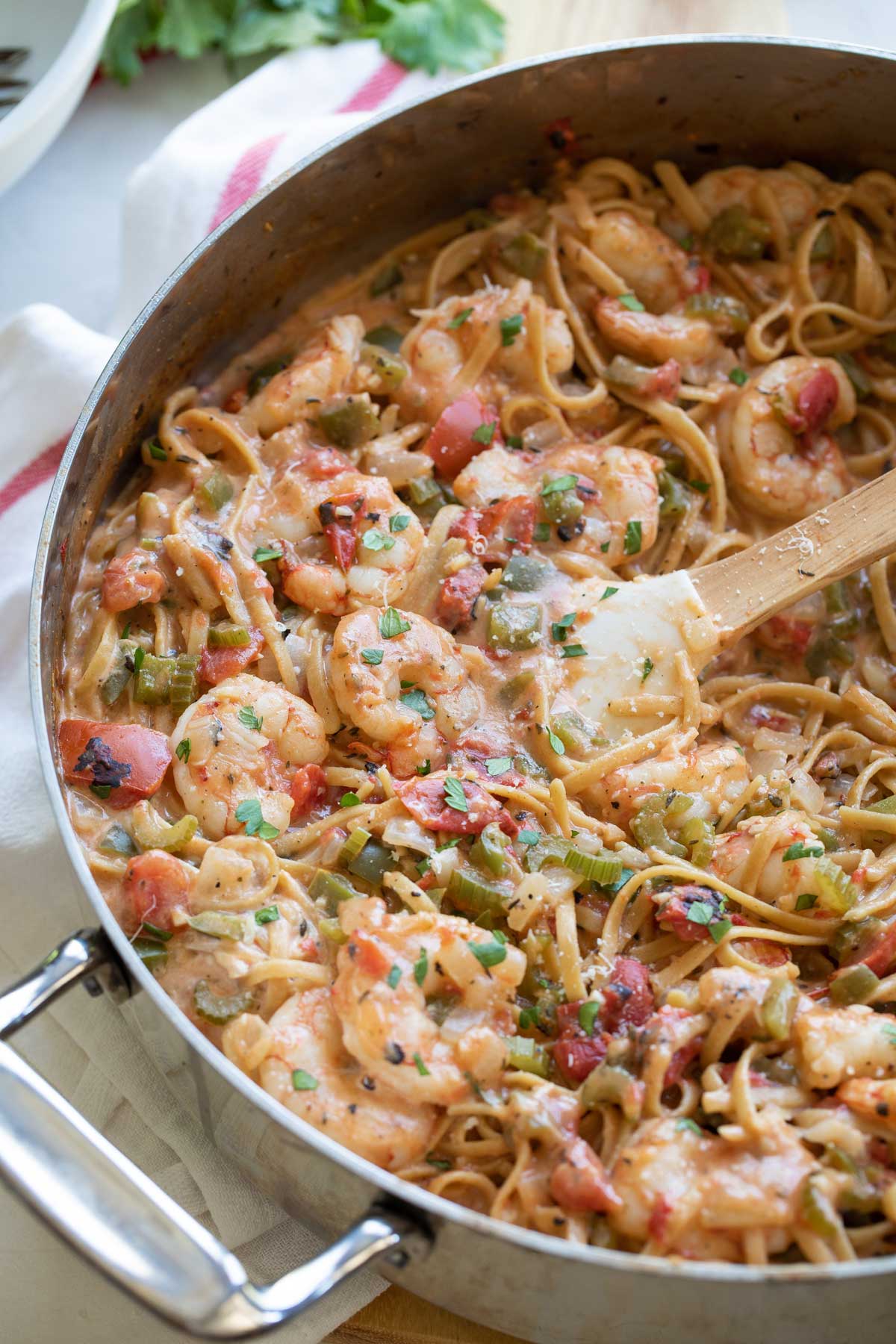
But there’s a sneaky side benefit to this method, too.
As pasta cooks, it releases starch into the cooking water. As Kitchn explains, that starch acts as a thickener and binding agent.
In one-pot pasta recipes, the starchy cooking water reduces into a perfect base for a rich, creamy sauce … no butter or heavy cream needed.
Brilliant!
Now, in this recipe, we do add a dab of Neufchâtel cheese (aka reduced-fat cream cheese) to pump up the creamy richness even more and smooth out the edges, bringing all the flavors together. (It’s the same strategy we use in our One-Pot Jamaican Rasta Pasta.) But that’s a much better choice than the butter plus a cup or two of full-fat heavy whipping cream (or even half-and-half or whole milk) that you’ll typically find in a creamy Cajun Shrimp Pasta recipe.
The starchy base sauce from the one-pot cooking method isn’t just easy … it’s also a healthful way to begin building a mock Alfredo sauce that’s still decadent, satisfying and delicious, yet also so, so much lighter and waistline-friendly!
Ok. Problems solved … so, let’s get cookin’!
How to Make Cajun Shrimp Pasta in Just One Pot
Ingredients and Prep
There’s not much prep work with this recipe, just a bit of quick chopping.
But I do recommend that you have all your ingredients gathered up next to the stove, so it’s all ready to go at the right point in the process.
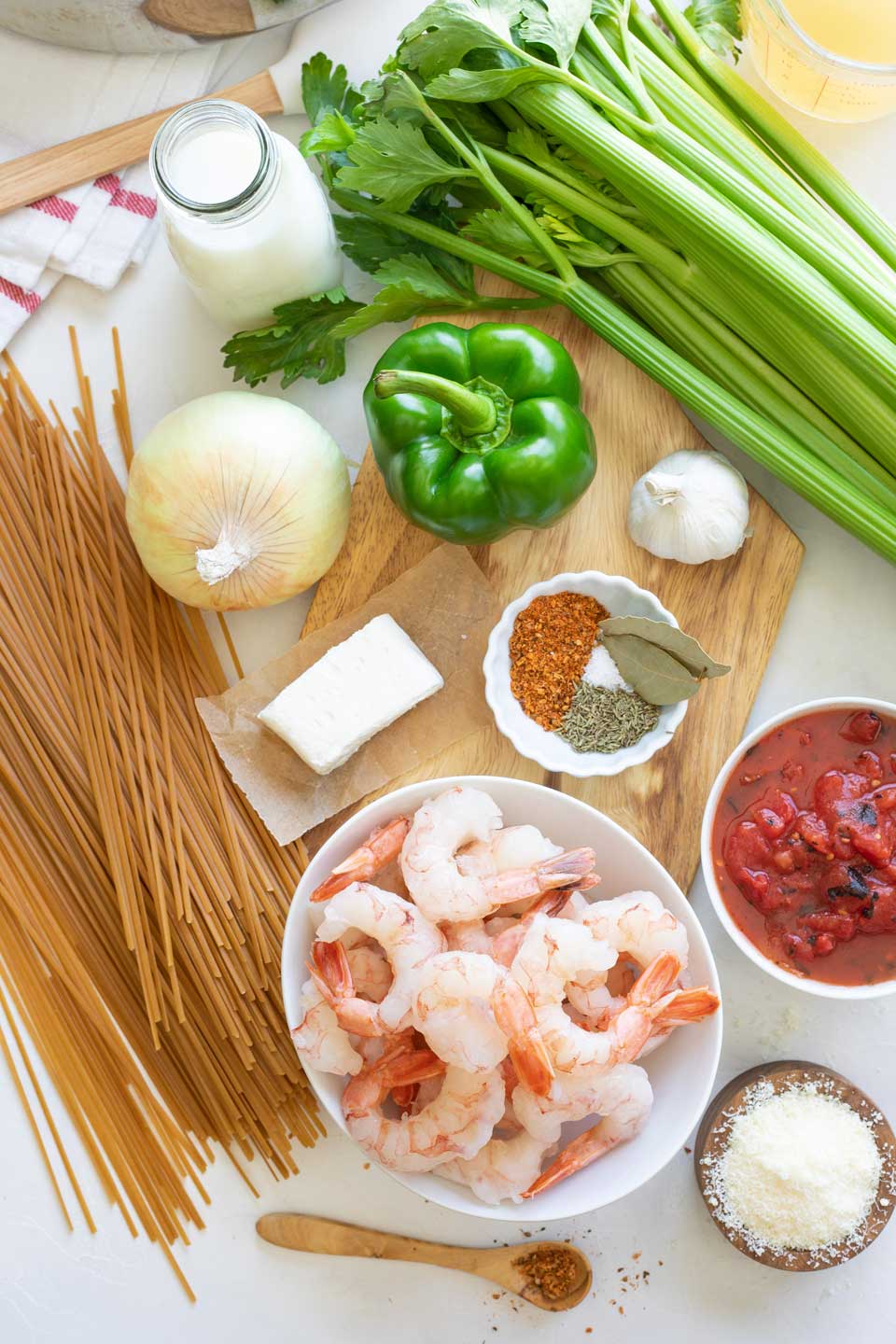
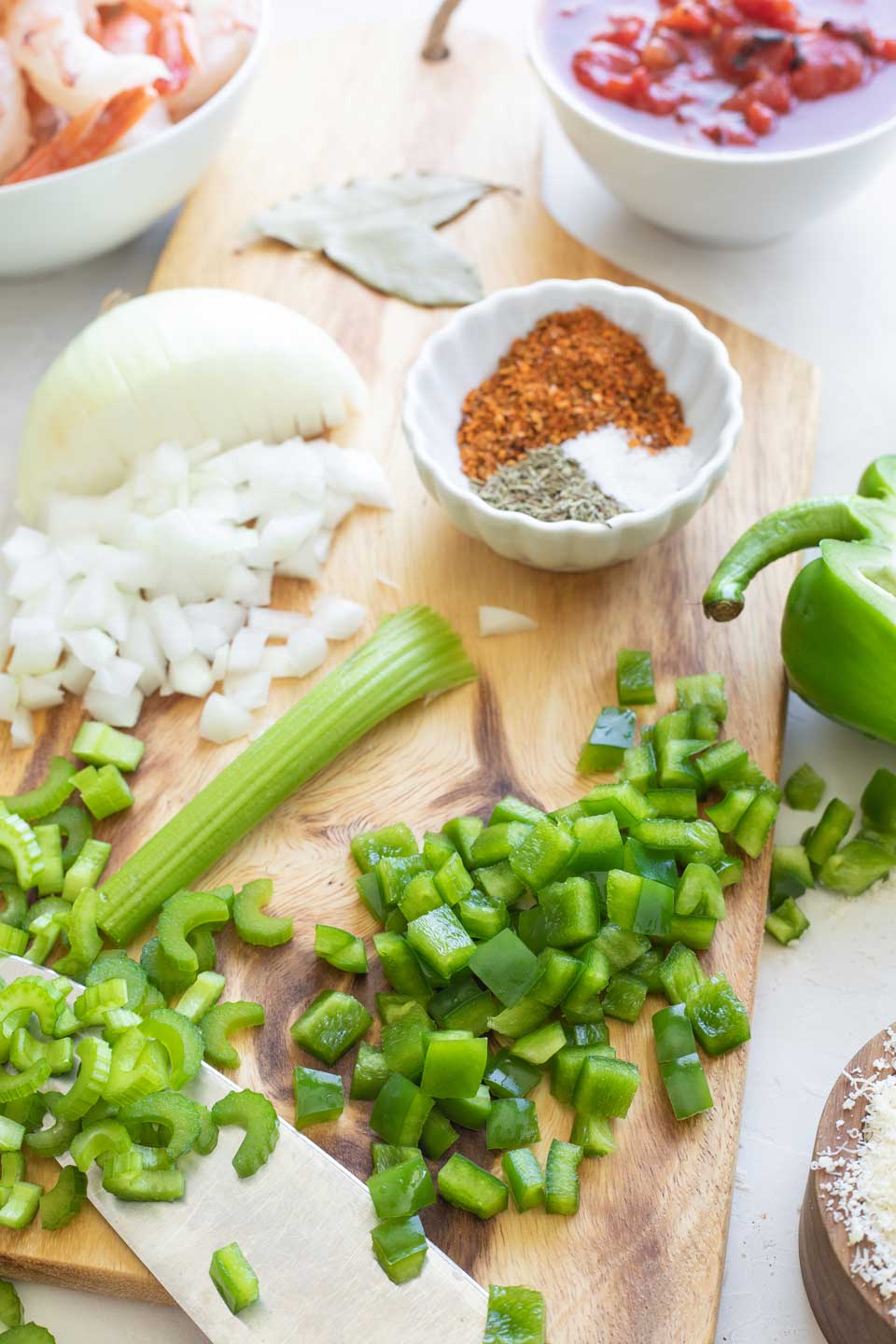
The only potentially tricky questions here are about the shrimp. Specifically, regarding what size to use and how to buy them …
Ingredient Tip: What Size of Shrimp Is Best for Cajun Shrimp Pasta?
I like to use fairly large shrimp, typically ones labeled as 21/25. That “size” number relates to how many shrimp are in each pound. It gives you a rough idea of how big the shrimp will be, based on how many it takes to equal a pound. (So, 21/25 means that there will be about 21-25 shrimp in a pound.)
You can use larger or smaller shrimp, of course, depending on what’s available at your market. But you may need to adjust their cooking time slightly, so they still end up perfectly cooked.
You’re always going for that “just-cooked” stage … succulent and tender, not tough and dry. The quickest way to ruin gorgeous shrimp is to overcook them!
Pro Tip: Using Frozen Shrimp
You can certainly purchase fresh shrimp for this recipe, but I almost always use (thawed) frozen shrimp, for convenience. (Psssst … and remember you’re looking for peeled, deveined shrimp, so you don’t have to do all the peeling and prepping yourself. You may even find them with the tails removed: bonus!)
I like to grab a bag of frozen shrimp whenever I see a great sale (since shrimp can be expensive), and keep it on hand in the freezer to make this pasta at a moment’s notice.
There are 3 recommended methods for thawing frozen shrimp. I discuss all 3 in my article on How to Thaw Shrimp.
In a nutshell, the best ways are (1) overnight in the fridge, (2) submerging the entire, unopened bag in cold water, or (3) dumping the individual shrimp into a bowl of cold water. Again, you can read the details in my article HERE.
The most important thing is to thaw them gently to maintain their lovely, delicate texture. Defrosting in the microwave is never a good choice. And leaving them out on the counter for a couple hours simply isn’t a safe method.
Okey doke! Now that you’ve got your easy prep done … the cooking is super-easy, too! Here’s what you do, step-by-step:
Step #1
Heat your oil over medium heat in a large, heavy sauté pan.
Once the oil is hot, dump in your green bell peppers, onion, celery, and garlic and cook them until they begin to soften and the onions are a little translucent but not too browned. It should take about 8 minutes or so.
Be sure to give the veggies a quick stir now and then, so nothing browns too much and your tiny bits of garlic don’t burn.
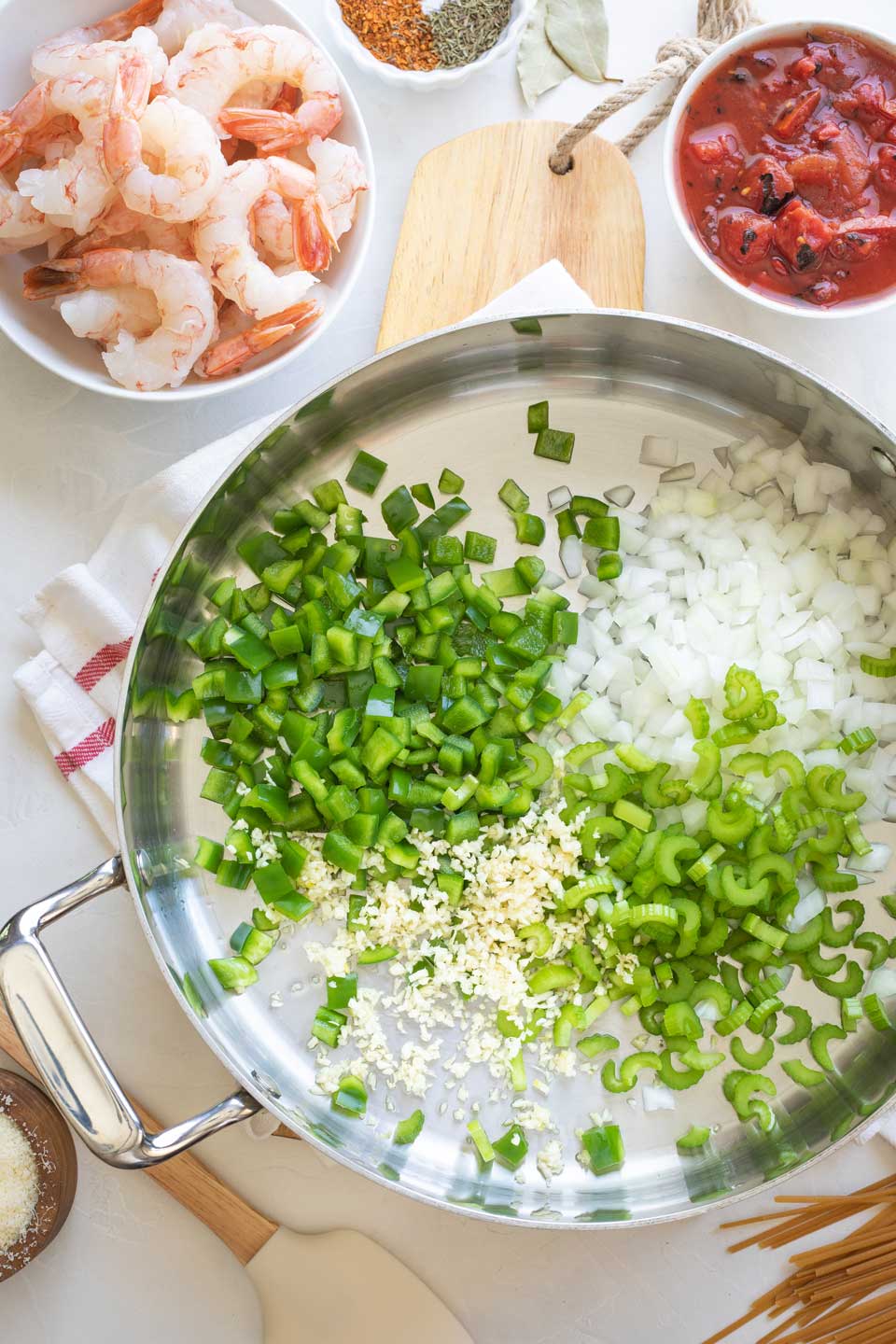
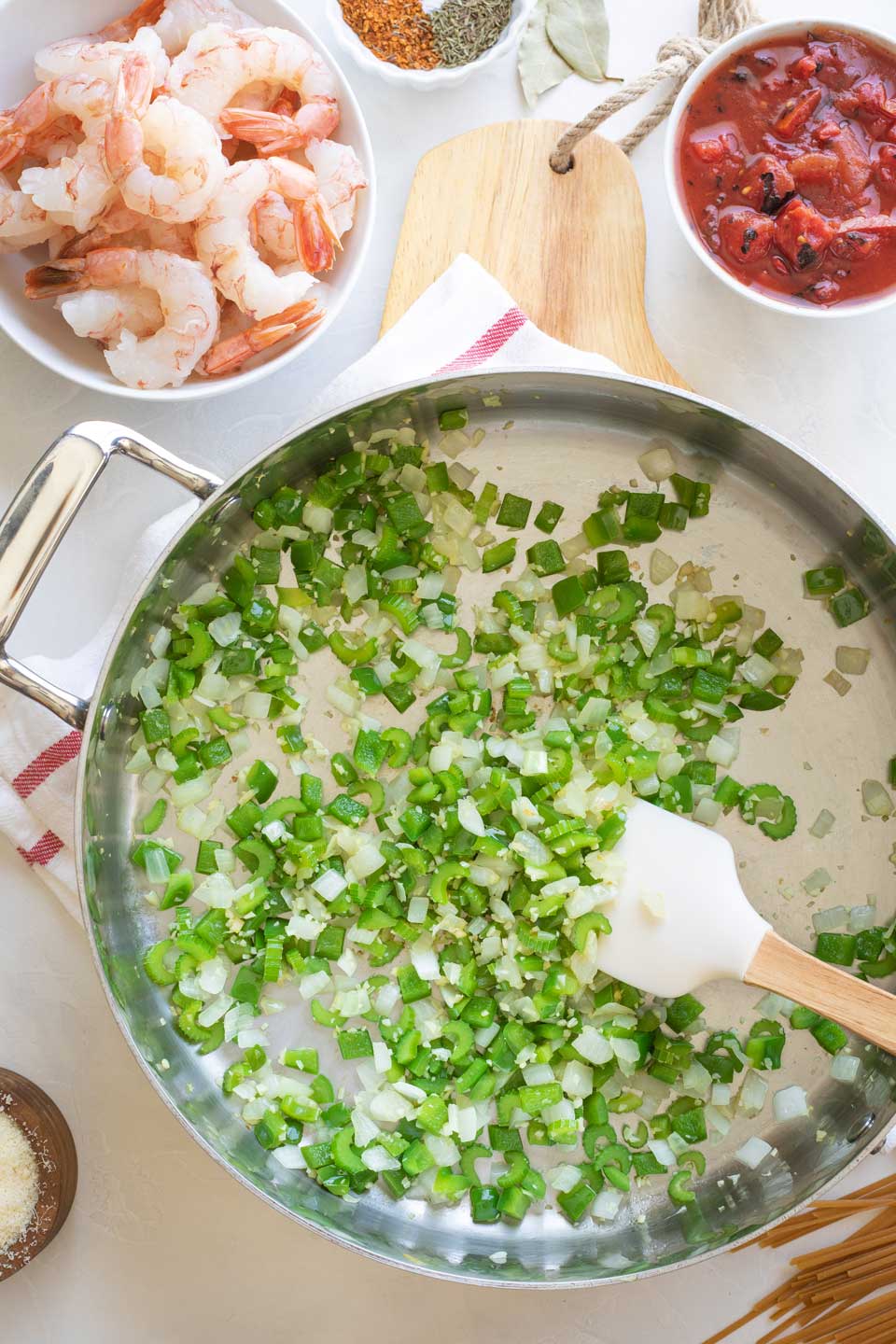
Step #2
Next, pour in your broth to deglaze the pan, stirring to loosen up any browned bits that might have formed. (But remember, there ideally shouldn’t be too much in the way of browning.)
Then add your pasta, and dump the undrained tomatoes, milk, Cajun seasoning, bay leaves, thyme, and salt on top.
Stir it up a little to combine everything, and also to help the pasta strands to begin to separate. You don’t want them to cook all stuck together in a clump.
Also, try to push the pasta down, so it’s mostly submerged in the liquid as it cooks.
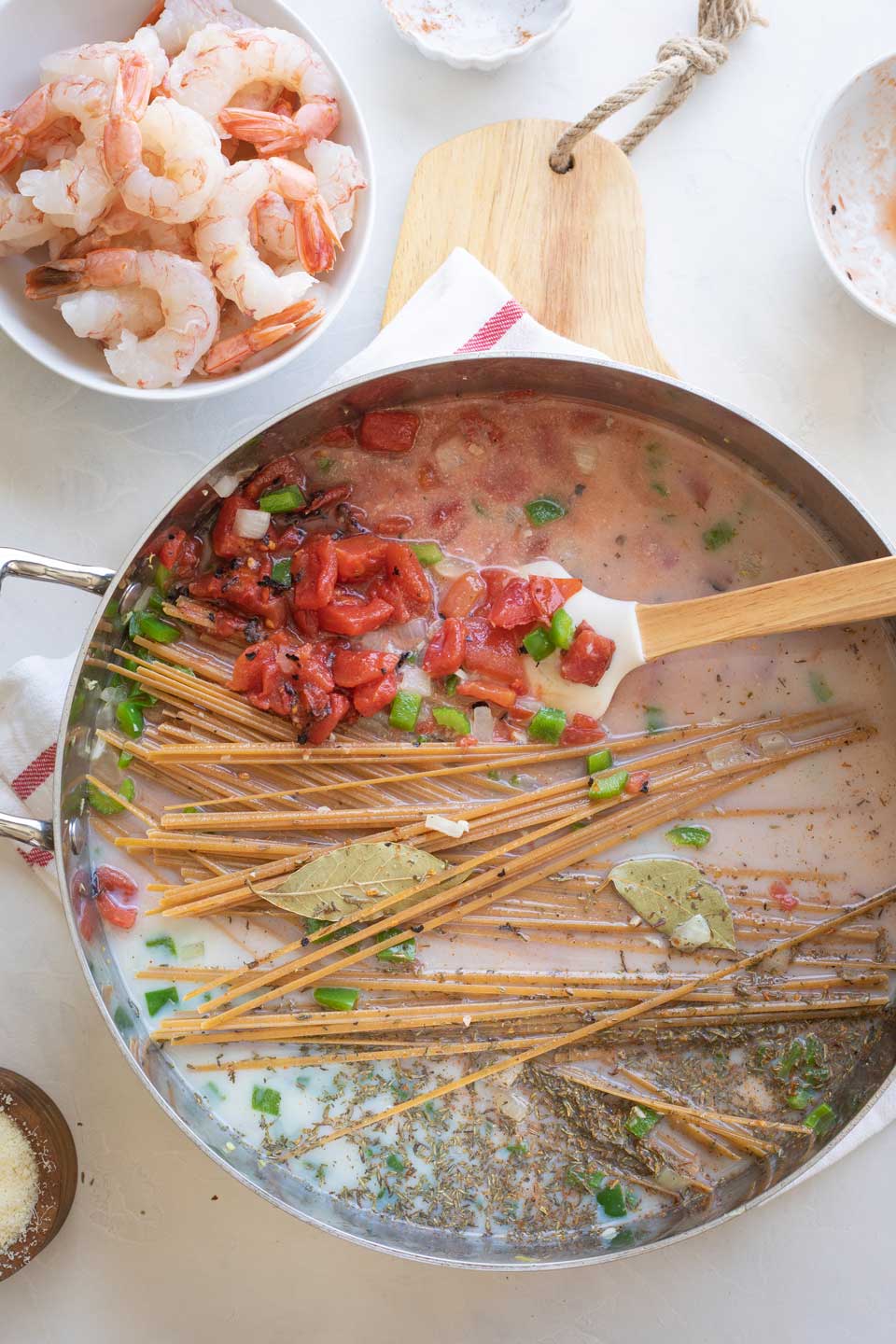
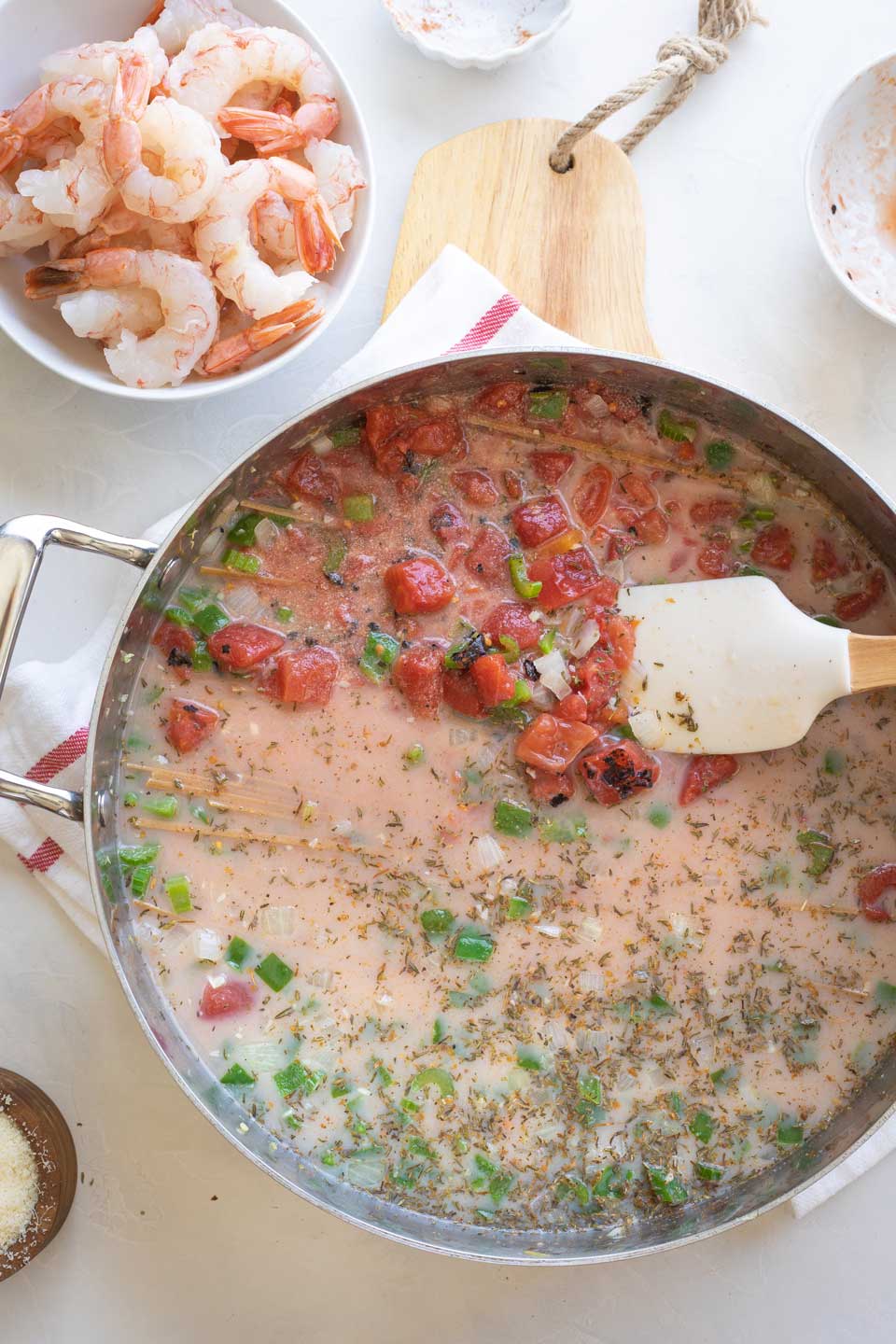
Cover your pan and increase the heat to bring it up to a boil.
Step #3
Once that glorious mixture comes to a boil, reduce the heat back to about medium or medium-low. You want to maintain a lively simmer, but NOT a hard, full, rolling boil.
At this point, you’re free to help with homework, make a phone call, toss in some laundry … whatever else needs to get done (like, ALLLL the things, right?!?!). Just be sure to wander past the stove occasionally to take the lid off and give everything a good stir. You want to keep the pasta submerged in the sauce as much as possible, but also stir it around enough that it stays separated and un-clumped.
Precisely how long the cooking will take depends on your brand of pasta, but you’re roughly looking at about 10-13 minutes.
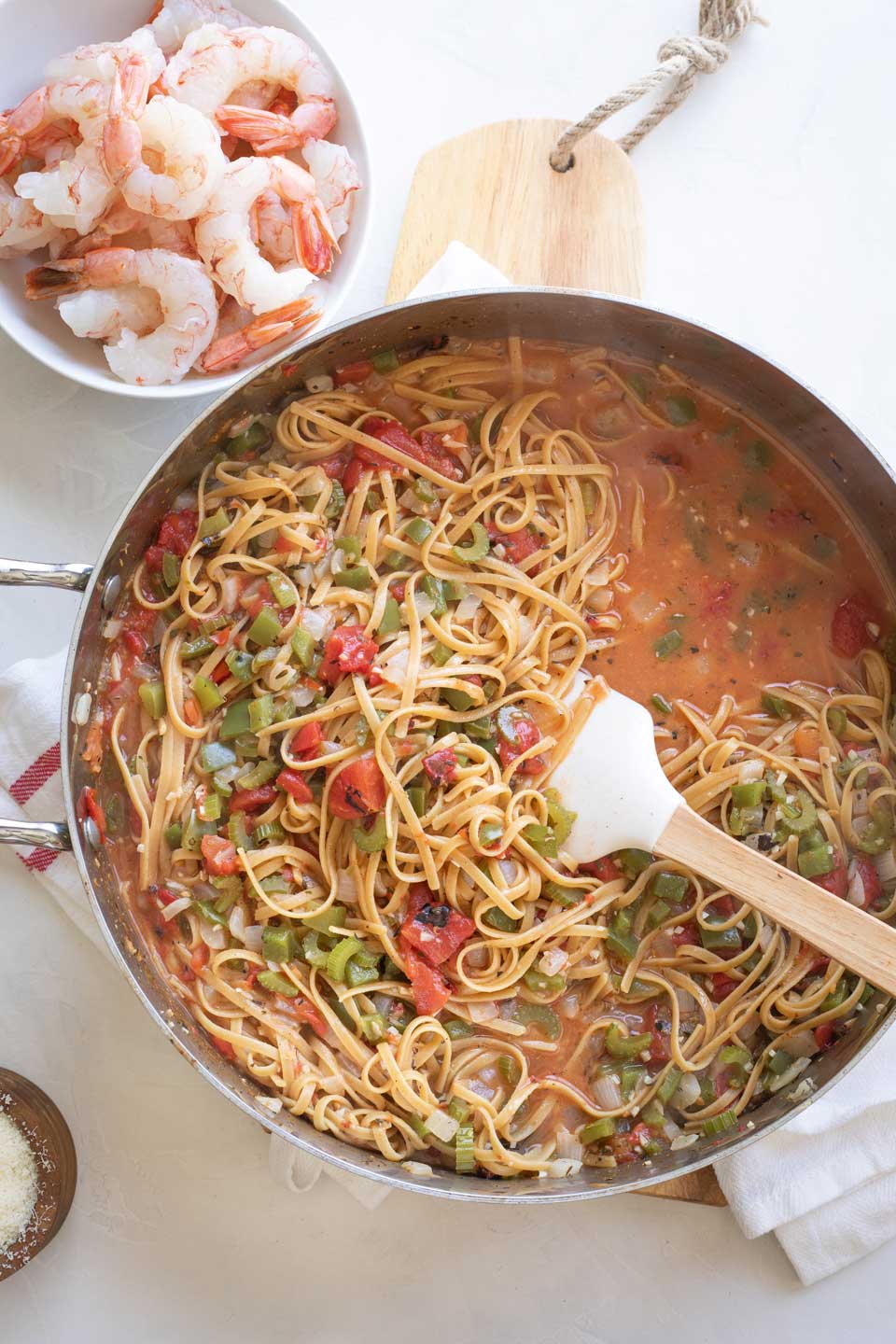
Step #4
Once the pasta is al dente, stir in your raw shrimp and continue cooking your meal (covered) until the shrimp are just done.
This happens pretty quickly.
For the fairly large-ish 21/25 size I usually use, that’s gonna take only about 3 minutes.
Remember here … the shrimp cooks quickly.
The easiest way to ruin fabulous shrimp is to overcook them. Don’t do it!
(As you can see in my photos, I prefer to remove the shells from the shrimp tails before cooking – if they weren’t already removed when I bought them – but that’s a matter of personal preference and entirely up to you. If you want a more “chef-y” presentation, feel free to leave the shells on the ends of the tails, to be removed as people are eating.)
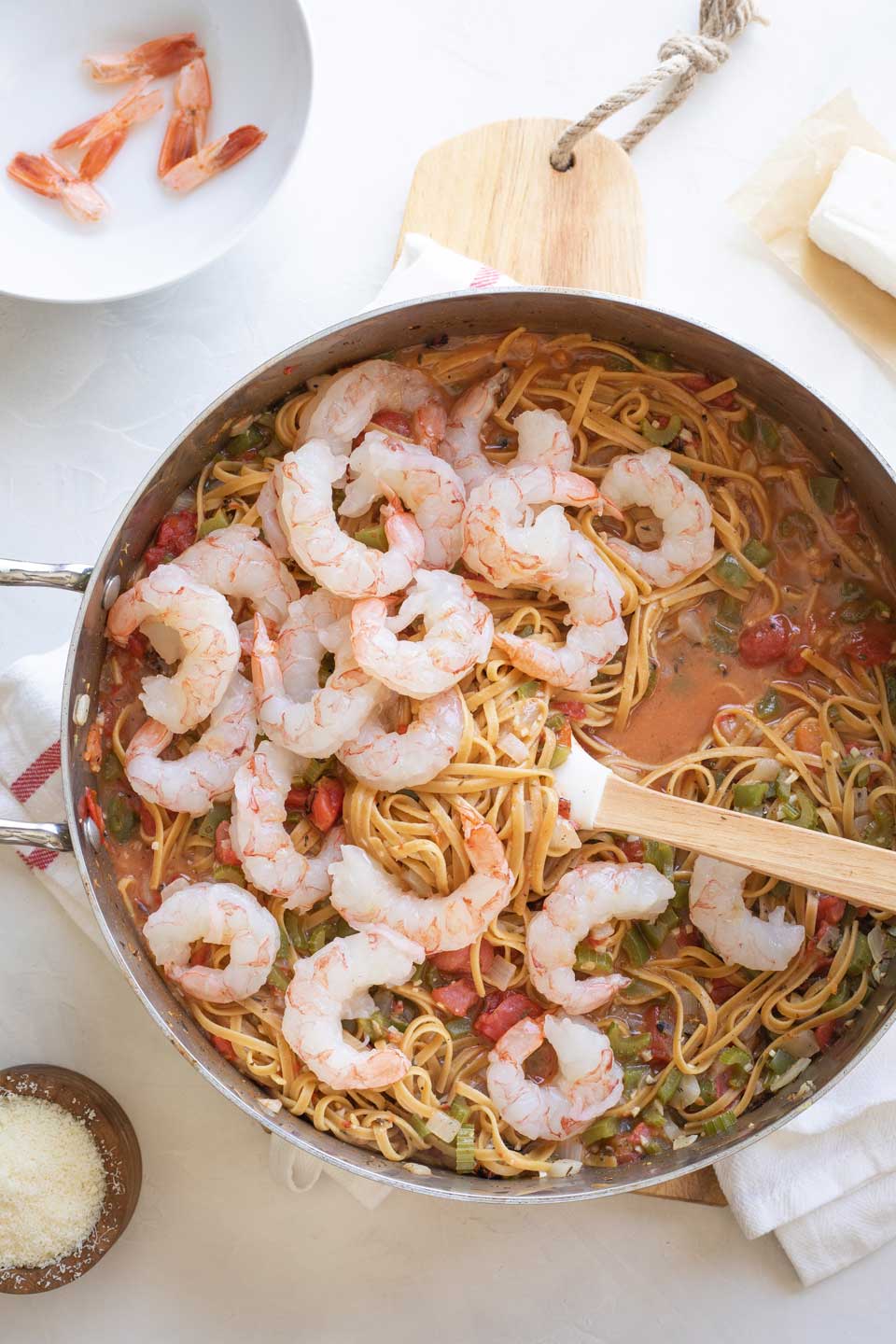
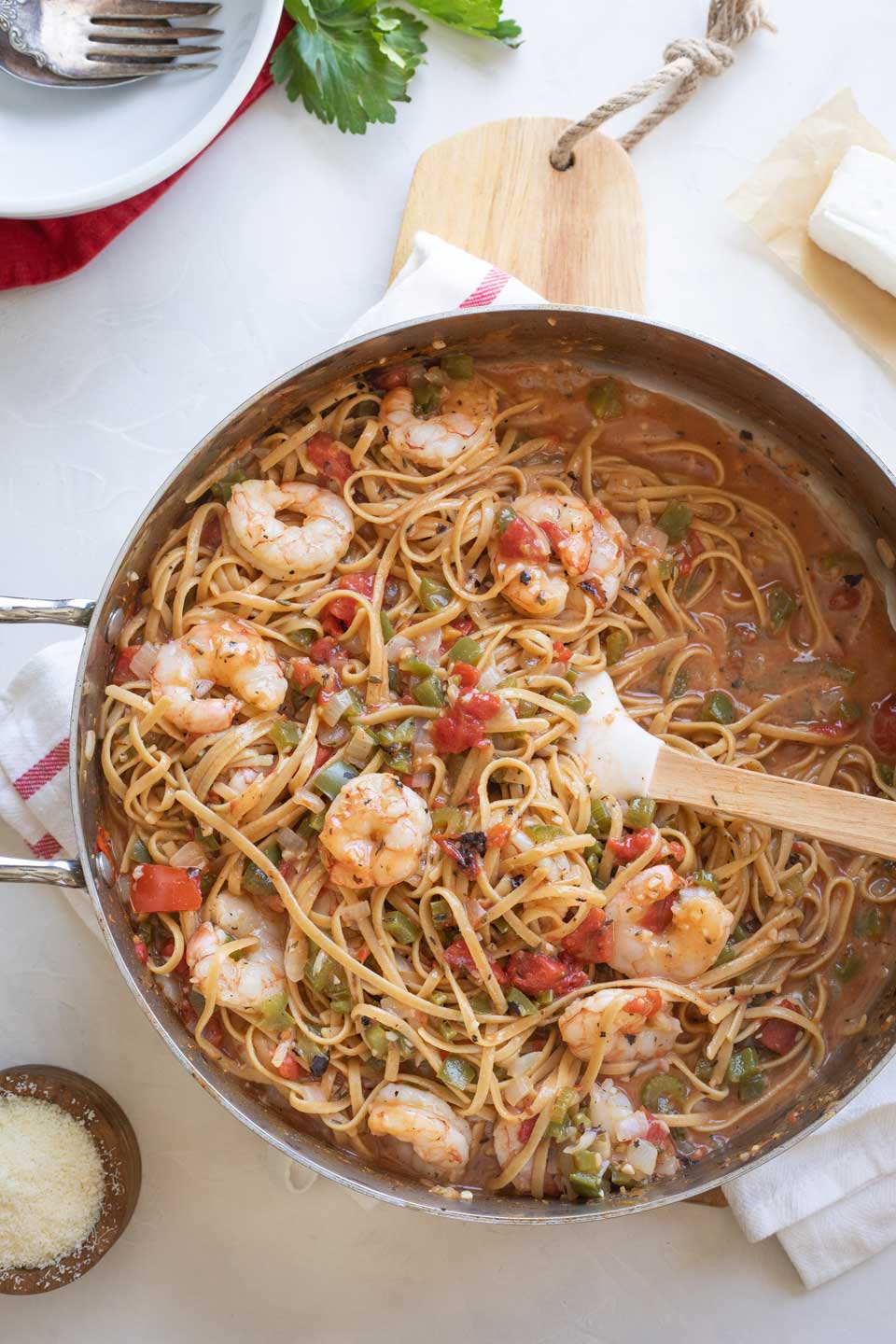
Step #5
Now for the extra boost of creamy-dreamy cheesy yumminess …
Stir in the parmesan cheese and Neufchâtel cream cheese to make your creamy Cajun sauce really creamy. Yes … YUM!
Ingredient Tip: What Is Neufchâtel Cheese?
Neufchâtel cheese is marketed in America as simply “reduced-fat cream cheese.” (Look closely, and you’ll usually see the fancy-schmancy name printed in tiny letters on the packaging.)
You can read more about what Neufchâtel is HERE. But, the main thing to know is that Neufchâtel is lower in calories, saturated fat and cholesterol compared to “regular” full-fat cream cheese. Yet, it tastes so much like the full-fat version that nobody will ever even notice the difference.
We use it frequently as one of the “tricks” to lightening up recipes and making them healthier … from our Grape Salad with Cream Cheese-Vanilla Dressing to our Healthy Buffalo Chicken Dip to our Sweet and Spicy Cream Cheese Dip, which features Neufchâtel in place of full-fat as the MAIN ingredient (and still, no one can tell the difference!).
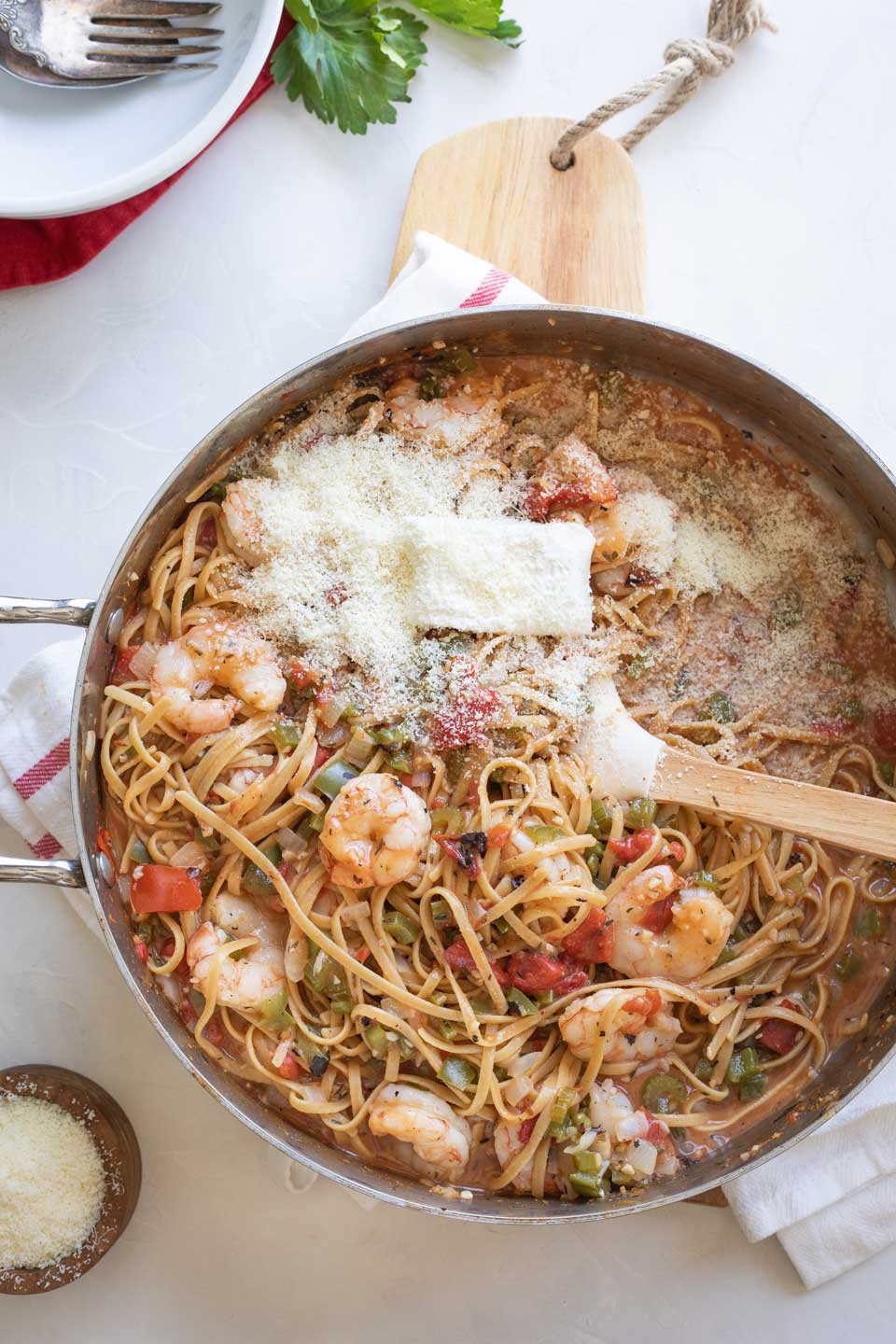
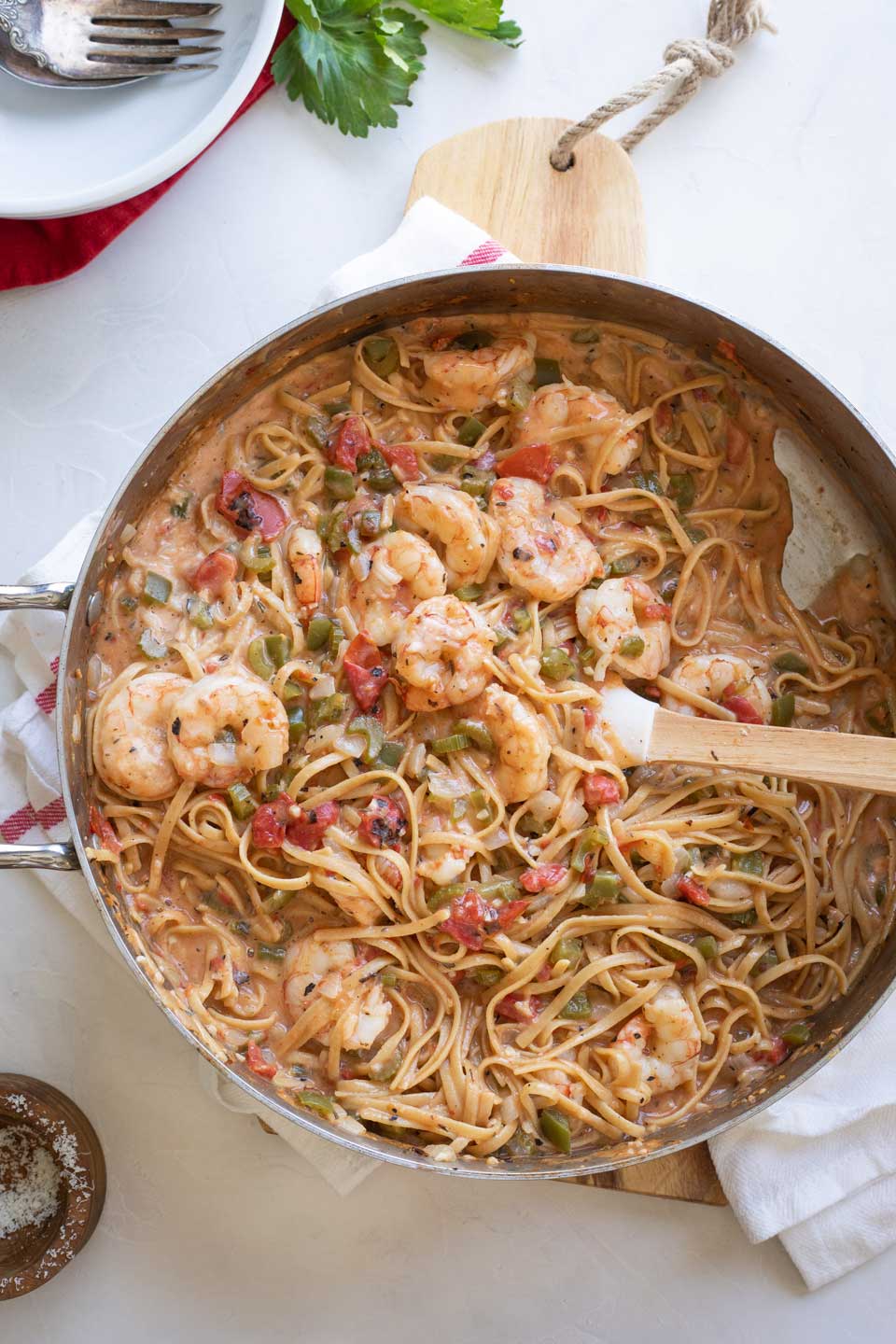
Keep stirring until the cream cheese is completely melted and the cheeses are evenly distributed all throughout the dish.
Step #6
Pull your dinner off the heat, discard the bay leaves, and serve it up!
Sure, you can get a little extra fancy and garnish it with some fresh parley for a pop of color, if you’d like. Or a sprinkling of alluring parmesan, to hint at the creamy vibes within.
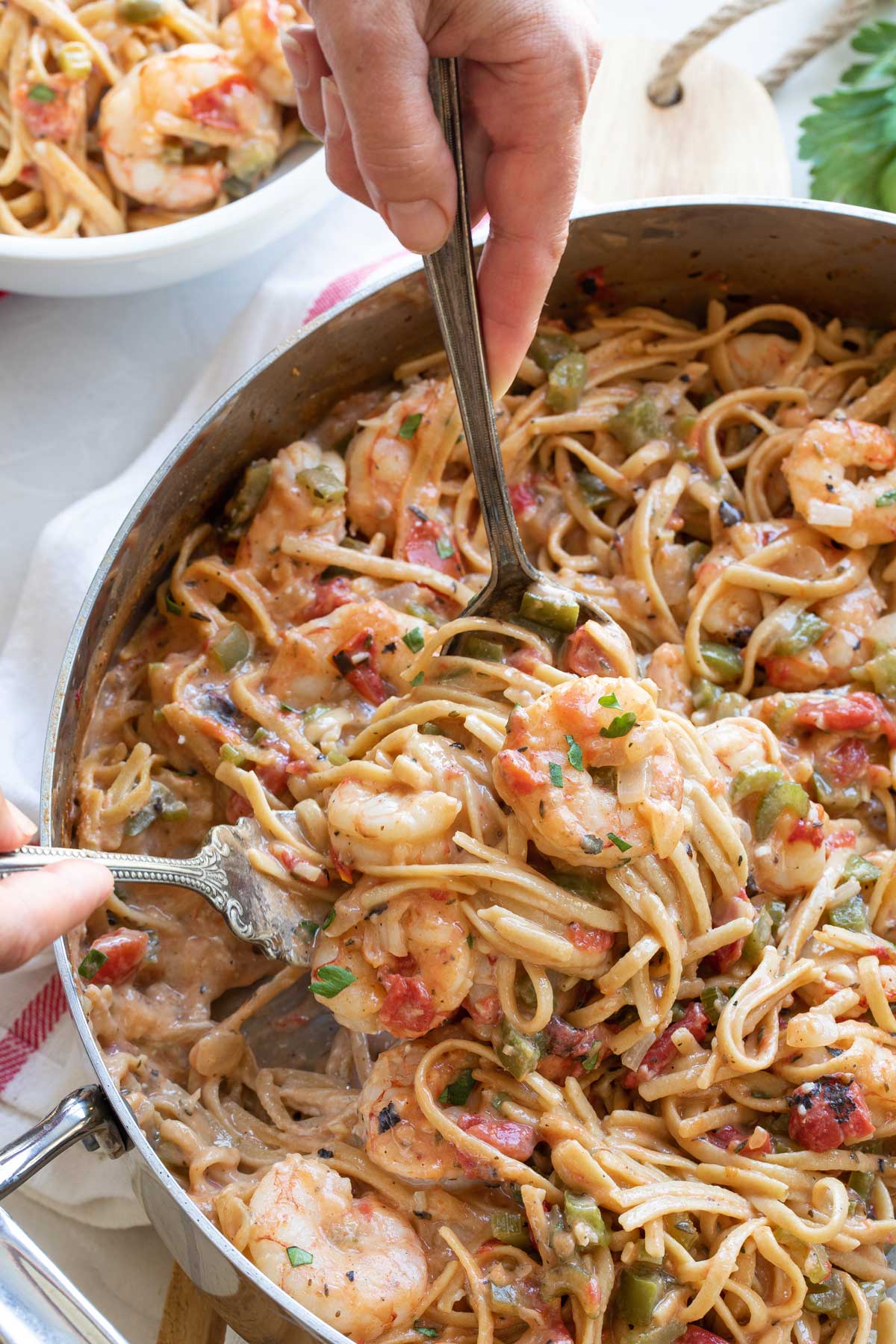
But that’s all totally optional. Your family is gonna love it just as much if you carry the pan straight to the table and start scooping up helpings … with no fussy garnishes or sprinklings at all.
Trust, me … this glorious dinner really doesn’t need any fru-fru bling. It screams “YES … I AM ABSOLUTELY DELICIOUS” all by its humble, one-pot, no-frills self!
Psssssst … and Don’t Miss …
How to Reheat Your Cajun Pasta
Surprisingly, this dinner works well as a make-ahead meal for busy weeknights. And leftovers (in the unlikely event that you happen to have any!) are great a day or two later, as well.
You can gently rewarm it either on the stovetop or in the microwave.
Either way, the key is to reheat gently. You don’t want to overcook and toughen the shrimp. Always go with a low, gentle heat until everything is just heated through.
FAQs At-a-Glance
I don’t recommend it, since it won’t release the starch that forms the base for the Alfredo-like Cajun cream sauce.
Whenever possible, we prefer to use whole grain or whole wheat pasta in cooking, because of the boost in nutrition compared to refined, white pasta. In a pinch, however, you can alternately try using “regular” white pasta, although the cooking time to reach a perfect al dente may be slightly different. As you may notice from their package instructions, cook times for “regular” pastas are typically shorter than for whole grain and whole wheat pastas, so check for the perfect al dente doneness earlier.
We used McCormick Gourmet Cajun Seasoning throughout our recipe testing. I try to go with mainstream brands like McCormick, so that most everyone across America will likely be able to find them easily. If you’re trying some other brand, be aware that it will probably vary somewhat in the exact spice formulation, and quite possibly also in its level of spicy heat. You’ll likely see a combination including things like black pepper, cayenne pepper, oregano, chili pepper, salt, and paprika. But the exact spice mix varies from one brand to the next, and can also vary, of course, if you opt to use a homemade Cajun seasoning. So, you may need to slightly adjust the amount of Cajun seasoning you use in this recipe to taste. Also, you may need to slightly teak the amount of kosher salt you’re adding, depending on the amount of salt that’s included in your Cajun seasoning blend.
Another popular riff on this theme is Cajun Chicken Pasta. To give that a try, swap out the shrimp for cooked chicken breasts that you’ve chopped or thinly sliced into bite-size pieces. A rotisserie chicken is an easy option here, but you can also use your own pre-cooked or leftover chicken, as long as it isn’t marinated or seasoned in a way that would compete with the Cajun flavors of this dish.
If love spicy food and wanna pump up the heat, try adding a pinch of ground red pepper or cayenne, tasting as you go so you get the right amount of kick without overdoing it. Alternately, you could pass your favorite hot sauce at the table, so everyone can dial up the heat to their own liking.
Want to make a restaurant-quality dinner at home? On even a busy weeknight?? AND that you can actually feel awesome serving to people you really care about (and their waistlines and arteries)???
It’s not too much to hope for. This recipe checks every single box!
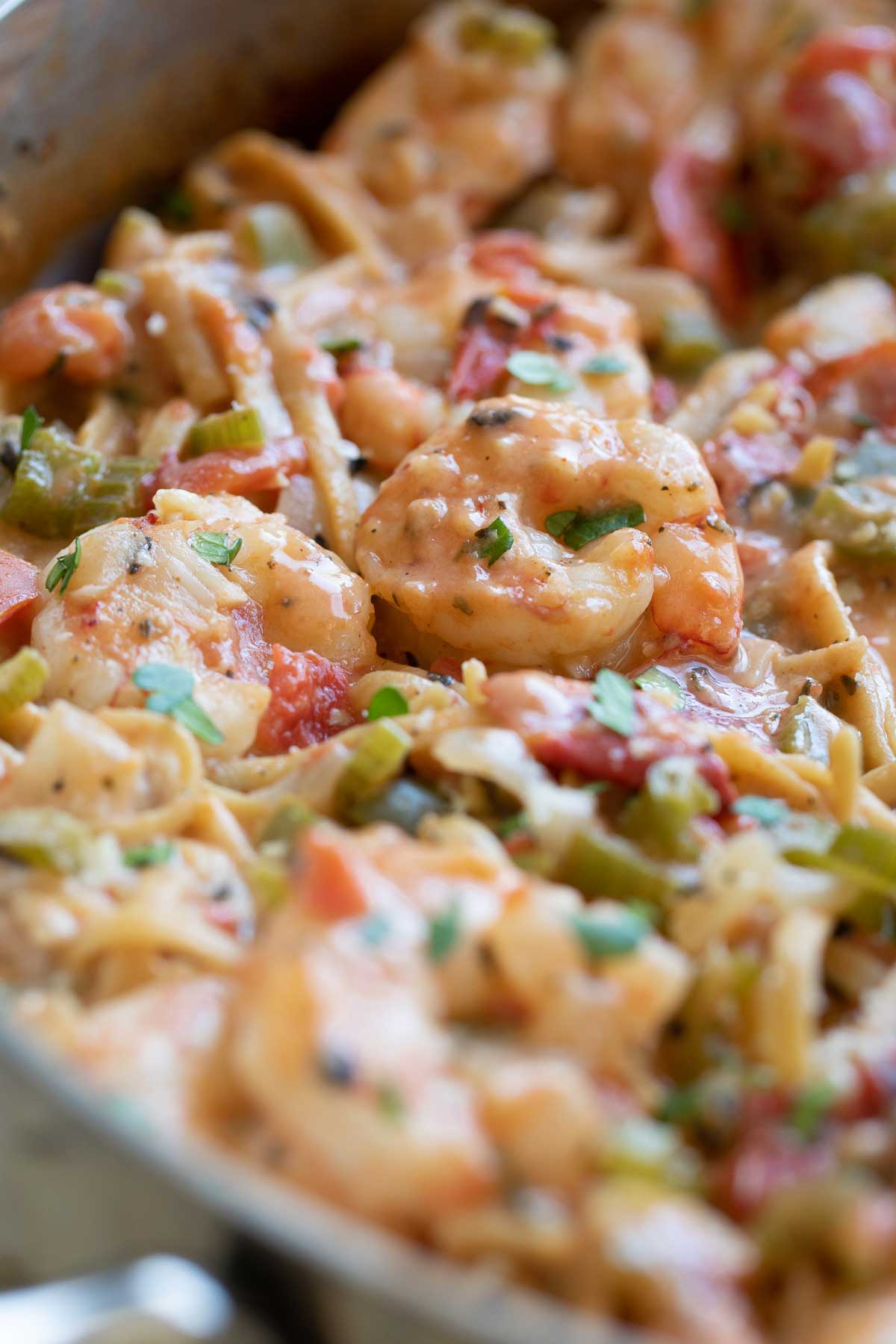
Try it this week, and see for yourself why my own family fell so in love with this recipe.
And then pat yourself on the back for whipping up a scrumptious, restaurant-caliber meal that is cleverly so much more nutritious (and gosh … so much easier to make, too).
So many wins here!

~ by Shelley
Love the Recipe? • Were My Tips Helpful?
__________
Please leave a 5-star rating by clicking on the stars in the recipe card below. I truly appreciate all your wonderful feedback!
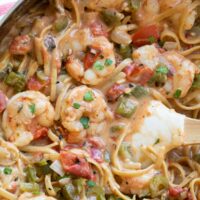
One-Pot Creamy Cajun Shrimp Pasta
Ingredients
- 1 teaspoon olive oil
- 1 cup chopped green pepper
- 1 cup chopped yellow onion
- ½ cup thinly sliced celery
- 2 tablespoons minced garlic
- 1 (14.5-ounce) can fat-free, reduced-sodium chicken broth
- 8 ounces linguine or fettuccine (we use whole wheat or whole grain)
- 1 (14.5-ounce) can fire roasted diced tomatoes, undrained
- 1½ cups nonfat milk
- 2½ teaspoons Cajun seasoning (we use McCormick; see note)
- 2 bay leaves
- 1½ teaspoons dried thyme leaves
- ½ teaspoon kosher salt
- 1 pound uncooked, peeled and deveined shrimp, tails removed if desired (we use 21/25 size; see note)
- ¼ cup grated parmesan cheese
- 2 tablespoons reduced-fat cream cheese (Neufchâtel cheese)
- optional for garnish: chopped fresh parsley or extra parmesan
Instructions
- Heat oil over medium heat in a large sauté pan. Add green pepper, onion, celery, and garlic. Cook for about 8 minutes, stirring occasionally, until they begin to soften and the onions are a little translucent but not too browned.
- Add broth to deglaze the pan, loosening any browned bits. Then add pasta, undrained tomatoes, milk, Cajun seasoning, bay leaves, thyme, and salt. Stir to combine and separate the pasta a little. Cover the pan and increase heat to bring it to a boil (this usually takes 3-4 minutes on my stove).
- Once it comes up to a boil, reduce the heat to about medium or medium-low, to maintain a lively simmer (not a full, hard, rolling boil). Continue cooking, covered but stirring occasionally and trying to keep the pasta mostly submerged, until the pasta is tender (which generally takes about 10-13 minutes, depending on your brand of pasta).
- Stir in shrimp and continue cooking, covered, until the shrimp are done (about 3 minutes for the 21/25 size we use). Do not overcook.
- Add parmesan cheese and cream cheese, stirring to melt the cream cheese and distribute the cheeses evenly.
- Remove from heat, discard bay leaves, and serve immediately, garnished with parsley and extra parmesan, if desired.
Notes
Nutrition
* Nutrition information should be considered an estimate only, and may vary depending on your choice of ingredients or preparation. No guarantees are made regarding allergies or dietary needs. Always consult a physician or dietician for specific advice and questions.
This recipe was inspired by an old Cooking Light recipe for Cajun Shrimp Linguine that used a more traditional cooking method and turned to half-and-half for creaminess. We slashed the fat even further and streamlined prep with the one-pot cooking method, which also allowed us some nutritional room to stir in a little parmesan for an extra layer of savory, cheesy, umami flavor.

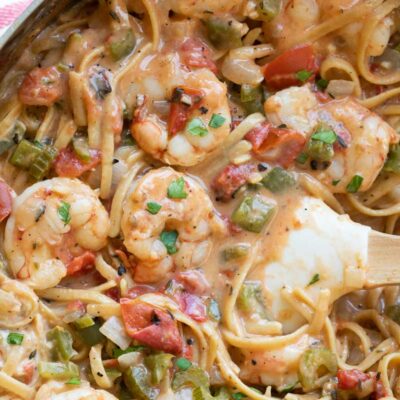
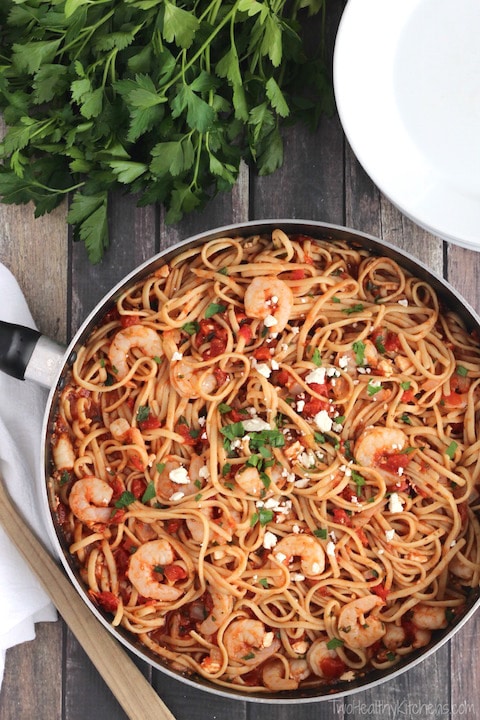
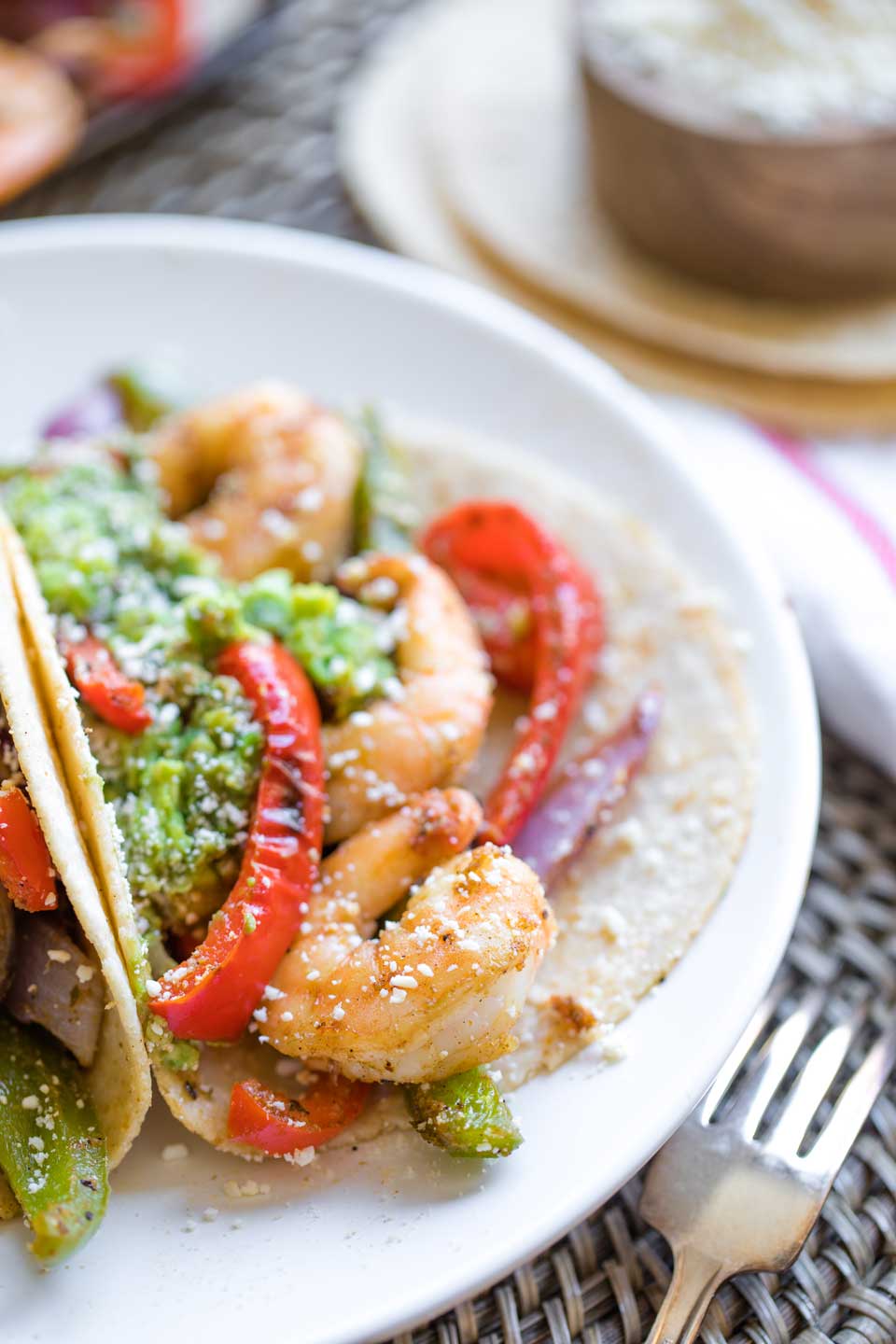
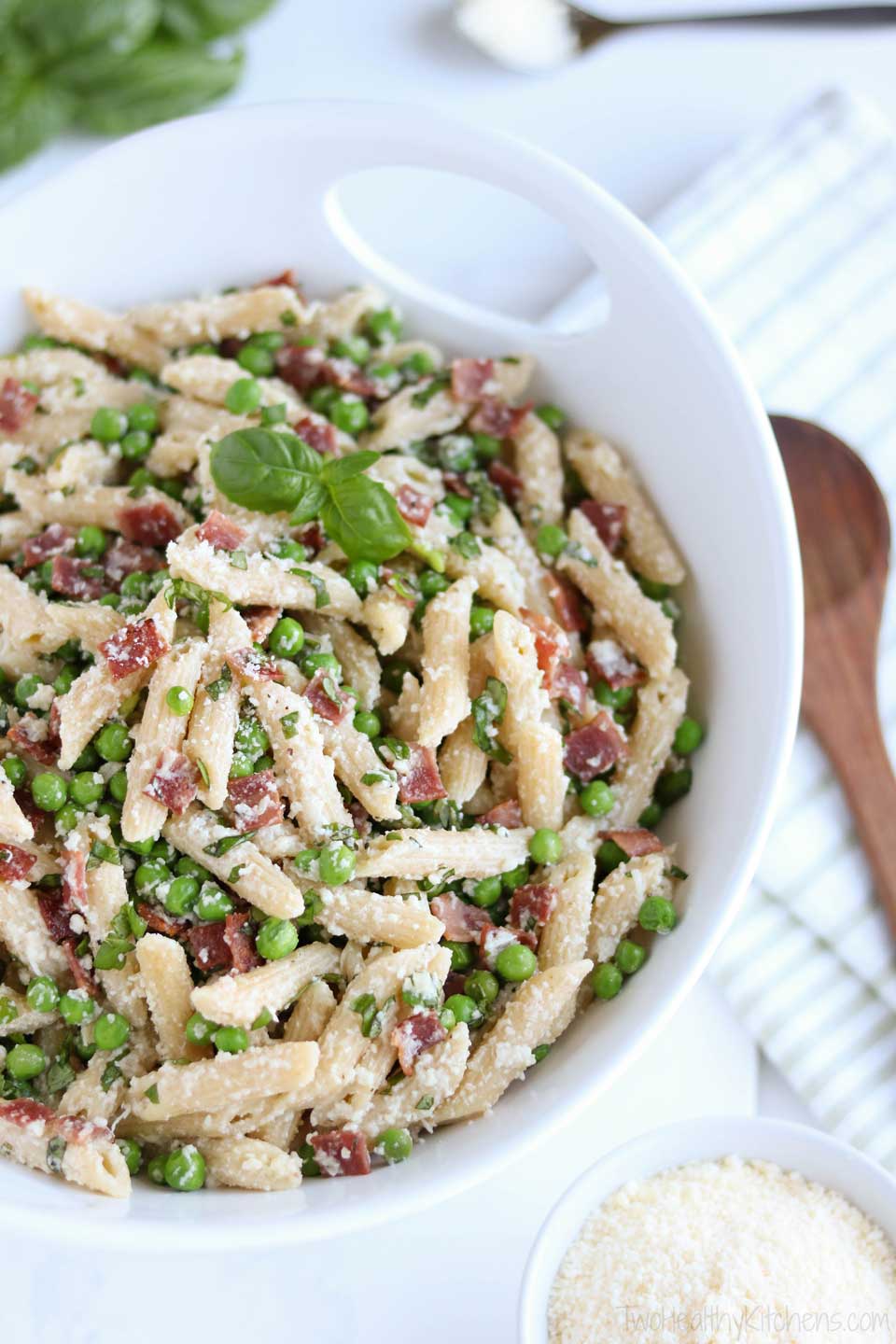
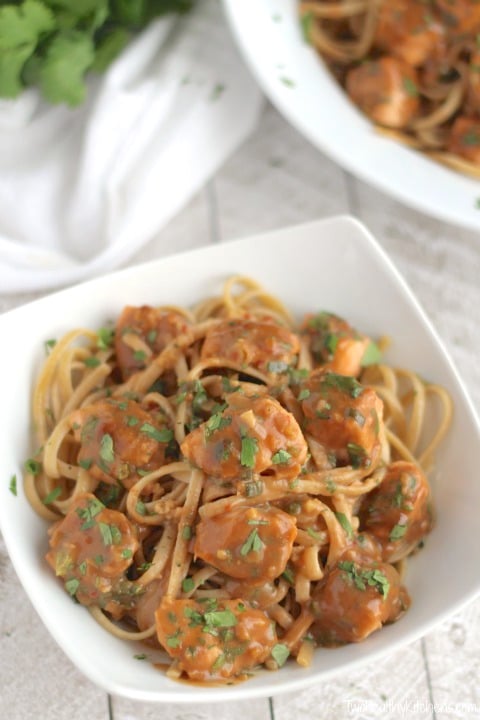
How would you convert to a crockpot recipe?
Hi, Cindi! Converting something like this pasta recipe into a slow cooker recipe opens up several different points where things might not work quite as expected – I wouldn’t feel comfortable advising you on that without rigorously testing it myself first. ~Shelley
I made this for dinner last night, and we devoured it. The spices have just the right amount of heat to go along with the overall flavor, and the shrimp came out perfectly.
I agree – I just love how beautifully the shrimp turn out! I’m so happy that this was such a big hit for you, and I really appreciate the great feedback, Beth! 😀 ~Shelley
Love this recipe – so delicious, easy and creamy. Perfect for dinner. Thanks for sharing 🙂
Those are perfect words to describe why my family fell in love with this recipe – delicious, easy and creamy. Yum yum yum!!! I’m really happy you liked it, too, Elisa – thanks for the great feedback! ~Shelley
Amazing
Thank you for the great feedback, Dwain – I’m so happy you loved it! ~Shelley
This was everything a gourmet meal should be, and then some! Turned out perfectly creamy, hearty and delicious; easily, a new favorite recipe!
Oh wow – thank you, Sara! That’s a huge compliment coming from you … I’m really happy you enjoyed this so much, and that it turned out perfectly for you! 😀 ~Shelley